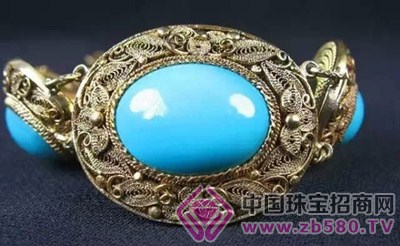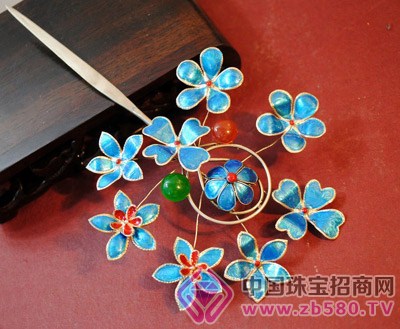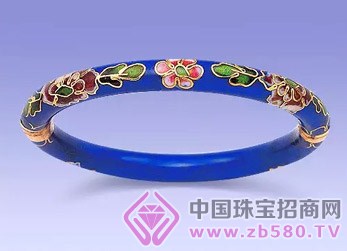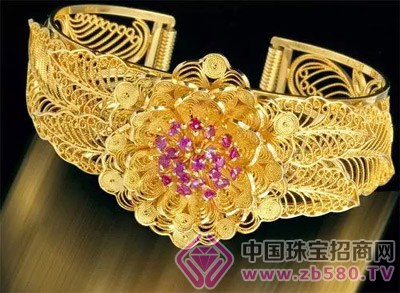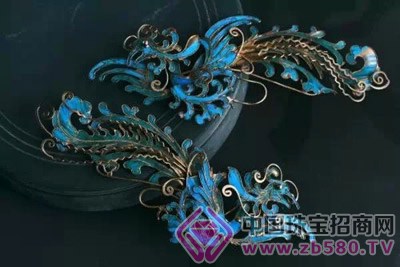The Chinese jewelry in the eyes of foreigners turned out to be like this!
1. The most magnificent gold and silver art - burning blue Also known as "Silver Blue" and "Silver", this process flourished in the Qing Dynasty. The silver-blue process is mainly applied to silver trim, which is an art combining the metal tire technology with the blue color scheme. In the northern part of China, the combination of filigree and burnt blue has been used in the production of various types of jewelry and three-dimensional silver ornaments. The blue-burning process of applying a layer of glaze on the silverware injects new vitality into the ancient jewelry. 2. The most complicated comprehensive art - cloisonne Also known as "copper tires and silkworms", it is the most famous traditional craft in China. Because it was popular during the Ming Dynasty, the production techniques were relatively mature, and the enamel glaze used was mostly blue, hence the name "cloisonne". The production process of cloisonne is a comprehensive art, which is the crystallization of art, craft, sculpture, inlay, metallurgy, glass smelting and other technologies. Its production process is sophisticated and requires more than 10 processes such as design, tire making, silking, blue, burnt blue, grinding, and gold plating. 3. The longest carving process - jade carving The Chinese jade carving craft has a long history of continuous development for more than 7,000 years. It originated in China, matured and prospered in the feudal society. It has produced countless skilled craftsmen and made countless jade carvings. These jade carving masterpieces not only use the rewards of emperors, dignitaries and connoisseurs, but also be interpreted by ritualists to become special works of art with political, religious, moral, cultural, wealth and other connotations. This is Chinese craft culture. The only phenomenon. Jade carving craft is a relatively complicated craftsmanship. The unique beauty, taste, style and value of each piece of work are not only revealed by the content and form of jade carving art, but also by the use of jade materials and tools. 4. The most magnificent palace art - filigree inlay Also known as the "fine gold craft", first began in the Shang Dynasty, the small silver headdress of the late Western Han Dynasty began to prevail. In the Ming and Qing Dynasties, the filigree process was praised as one of the “Yanjing Eight Mustsâ€. The filigree craftsmanship is rare and the craftsmanship is complex. It has always been a royal imperial object. It belongs to the court art and is also one of the traditional crafts of traditional luxury goods in China. It has been listed as a national intangible cultural heritage by the Ministry of Culture. The filament process is also called the filament process and the wire process. The gold, silver, copper, etc. are drawn into filaments, and then shaped by pushing, crepe, weaving and the like. It can be welded on the gold and silver square pieces to make the bottom support. The pearls, crystals, white jade, jade and other jewels can be fixed on the gold and silver jewellery at different angles according to the needs of the craftsman design. It can also be independently shaped to decorate a creative composition. In the details. 5. The most traditional metal carving art - engraving The tradition of engraving this traditional craft has a long history. It began in the late Spring and Autumn Period and prevailed in the Warring States period. The production techniques of engraving and carving on gold and silverware were mainly engraved and engraved. Engraving adds a lot of highlights to the work with its unique artistic charm. Different engraving techniques make the variety of patterns on ancient and modern gold and silver instruments rich and varied, such as peony, chrysanthemum, eight immortals, fairies, birthday stars, unicorns, dragons and phoenixes, birds, landscapes and other traditional Chinese styles. Because the operation process of the engraving process is relatively complicated and technically difficult, the craftsman is required to have a high comprehensive quality. It requires not only the foundation of painting and sculpture, but also the fitter, sheet metal, casting, welding, etc. Professional technology, there must be a certain understanding and appreciation of traditional culture. 6. The most "vibrant" craftsmanship - Point Cui As a craft of ancient jewelry, Dian Cui can be traced back to the Warring States Period. Point Cui first needs to collect Cui Yu, which is the feather of a brightly colored kingfisher, and then it is to build a living. Due to its complicated production process, the finished product is very difficult to store and the kingfisher feathers used are rare, and the environmental protection and other times require the traditional craft to be almost lost. Most of the modern jade craft ornaments that have been seen in the Qing Dynasty are the best products handed down in the Qing Dynasty. Point Cui is the perfect combination of traditional metal craft and feather craft in China. It is made of gold or gilt metal to make different patterns of the base, and then the beautiful Turkish blue feathers on the back of the kingfisher are carefully embedded in the seat. Jewelry utensils. 7. The finest gold and silver engraving process - gold and silver The gold and silver wrong process first began in the bronze wares of the Shang and Zhou Dynasties, mainly used for decorative patterns on bronzes. The expression method is to draw a delicate pattern on the surface of the object, draw a groove in the shape of a pattern, draw pure gold or sterling silver into a filament or press it into a pattern, and then polish it and polish it. The gold and silver wrong craft is the product of the combination of copper culture and iron culture. Because there is no hard ironware, it can't be finely carved on the bronze. With the glory of the bronze age, the gold and silver wrong craft has gradually withdrawn from the historical stage. . However, when these old gold and silver wrong crafts were seen again, the whole world was dumped for this exquisite art. Glitter Sequins Embroidery Fabric
The sequin of Glitter Sequins Embroidery Fabric we always use is glitter gold sequin ,glitter silver sequin.
For example,Glitter Gold Sequins Embroidery Fabric
Glitter Silver Sequins Embroidery Fabric
The glitter sequin is very shiny that you can recognize from above pictures.It's vogue.popular and deeply loved by customers.
Black Embroidered Fabric,9Mm Sequins Embroidery Fabric,Sequins Embroidery Lace Fabric,Glitter Sequins Embroidery Fabric SHAOXING MINGHEE EMBROIDERY CO,LTD , https://www.zjchemicallacefabric.com